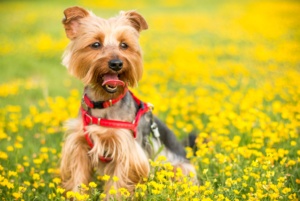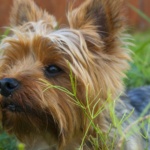
Understanding Your Yorkie’s Body Language: A Comprehensive Guide by YorkieShoutOuts.com
Decoding Your Yorkshire Terrier Emotions: A Comprehensive Yorkie Guide to Understanding Your Yorkies Dog Body Language
Dogs, our cherished companions, possess a rich set of emotions expressed through their body language. Understanding these cues is essential for nurturing a robust and balanced bond with furry friends. In this extensive guide, we’ll explore the nuanced world of Yorkie Terriers, focusing on their unique body language cues to decipher their emotions. From happiness to pain, Yorkies convey a spectrum of feelings, each accompanied by distinct body language. By recognizing and responding to these signals, we can deepen our connection and ensure the well-being of our beloved pets.
Yorkie Happiness: Wagging Tail – A Symphony of Joy
When a Yorkie is happy, their body language radiates pure bliss. A relaxed body, a wagging tail creating a joyful rhythm, an open mouth with a slightly lolling tongue, and playful behavior define their happiness. The joy in their eyes is evident, and their entire demeanor exudes contentment. Understanding these cues allows us to celebrate their happiness and contribute to their joyful moments.

Excitement: Yorkies Are A Burst of Energy
Excitement in Yorkie Terriers is contagious. Energetic behavior, a tail wagging enthusiastically, occasional jumping up and down, and expressive vocalizations through barks or whines characterize their excitement. Their eyes sparkle with anticipation, reflecting their eagerness for the adventure ahead. Acknowledging their excitement, we can engage in activities stimulating their curious minds and active bodies.
Aggression: Barking at Strangers – Unraveling Defensive Behaviors
Aggression is a potent emotion expressed through specific body language cues. A stiff body, raised hair or fur, growling, baring teeth, an intense stare, and a deep, throaty bark are signs of aggression. Aggressive dogs might also lunge forward or snap, setting boundaries and expressing discomfort. Understanding their aggression cues is essential for creating a safe environment and preventing conflicts.
Fear: Tucked Tail – Navigating Through Anxiety
Fear manifests in a Yorkie through subtle yet telling body language. A cowering stance, a tail tucked between their legs, ears pulled back, avoidance of eye contact, and sometimes trembling are signs of anxiety. In extreme cases, the dog might attempt to hide or retreat from the source of fear. Sensing their fear and providing reassurance and a safe environment helps them regain their confidence.

Anxiety: Trembling or tail tucked – Shown by your dog body language
Anxiety in Yorkies often translates into restless behavior. Pacing, excessive panting, whining, restlessness, yawning when not tired, and seeking comfort from their owner characterize their anxiety. Their eyes may appear wide, reflecting their unease. Providing a calm, secure environment and gentle reassurance can alleviate their stress and bring them a sense of peace.
Playfulness & Affectionate: Showing Affection Through Licking, Yawning, and Wagging
Playfulness in Yorkies is a delightful sight to behold. Bowing with front legs on the ground and hindquarters in the air, barking in a high-pitched tone, a wagging tail creating an exuberant rhythm, and inviting body language define their playfulness. Their eyes sparkle with joy, and their movements are agile and energetic. Engaging in interactive play strengthens the bond and fosters their playful spirit.

Submission: Showing the Belly – A Gesture of Trust
Submission in Yorkies is a vulnerable yet trusting gesture. Rolling over to expose their belly, licking their lips, avoiding direct eye contact, and sometimes urinating in submission are signs of their trust in the situation. Responding to their submission with gentleness and positive reinforcement deepens their sense of security and strengthens the bond between pet and owner.
Curiosity: Many Dog Breeds like the Yorkie Loves Exploring the Unknown
Curiosity fuels a Yorkie’s sense of wonder and exploration. A forward-leaning body, raised ears indicating alertness, sniffing the ground or air, and a slightly raised tail symbolize their curiosity. Their eyes are wide with interest as they absorb the world around them. Nurturing their curiosity with new experiences and environments enriches their lives and satisfies their curiosity.

Dominance: Tail Up High – Asserting Confidence
Dominance is expressed through assertive body language. Standing tall with an upright posture, making direct eye contact, leaning against a person or another dog, and placing a paw on another dog’s back or shoulder are signs of dominance. While asserting their confidence, Yorkies seek to establish their place in the social hierarchy. Responding with consistent boundaries and positive reinforcement helps maintain a harmonious relationship.
Contentment/Relaxation: Yawning – Embracing Tranquility
Contentment and relaxation are reflected in a Yorkie’s serene body language. A relaxed body, ears in a natural position, a tail held at a comfortable level (neither too high nor too low), and often lying down or sitting comfortably define their contentment. Their eyes are soft, and their breathing is steady, emanating a sense of tranquility. Recognizing their peaceful state allows us to respect their need for rest and quiet moments.

Frustration: Barking – Channeling Restless Energy
Frustration in Yorkies is often channeled through restless behavior. Pacing, whining, pawing at a closed door or window, and occasionally exhibiting obsessive behaviors like excessive licking or chewing are signs of frustration. Their eyes may convey a sense of impatience, reflecting their desire for resolution. Addressing the source of their frustration with patience and engaging in activities can help them redirect their energy positively.
Pain: Silent Suffering
When a Yorkie experiences pain, their body language undergoes subtle yet significant changes. Yelping, whimpering, flinching when touched, limping, decreased appetite, and alterations in overall behavior, such as becoming unusually aggressive or withdrawn, are signs of discomfort. Their eyes may reflect a sense of distress, and their movements might become hesitant. Identifying their pain cues promptly and seeking veterinary care is essential for their well-being and comfort.
Decoding the body language of Yorkie Terriers is akin to learning a beautiful, silent language that speaks volumes about their emotions, needs, and desires. By honing our ability to interpret these cues, we can respond with love, empathy, and understanding, ensuring the happiness and well-being of our cherished companions. Each wag of the tail, each curious sniff, and each trusting glance deepen the bond between us and our Yorkies, creating a relationship founded on mutual respect and unconditional love. So, let us observe, learn, and cherish the intricate language of our furry friends, making every moment together a testament to the enduring power of our shared connection.





